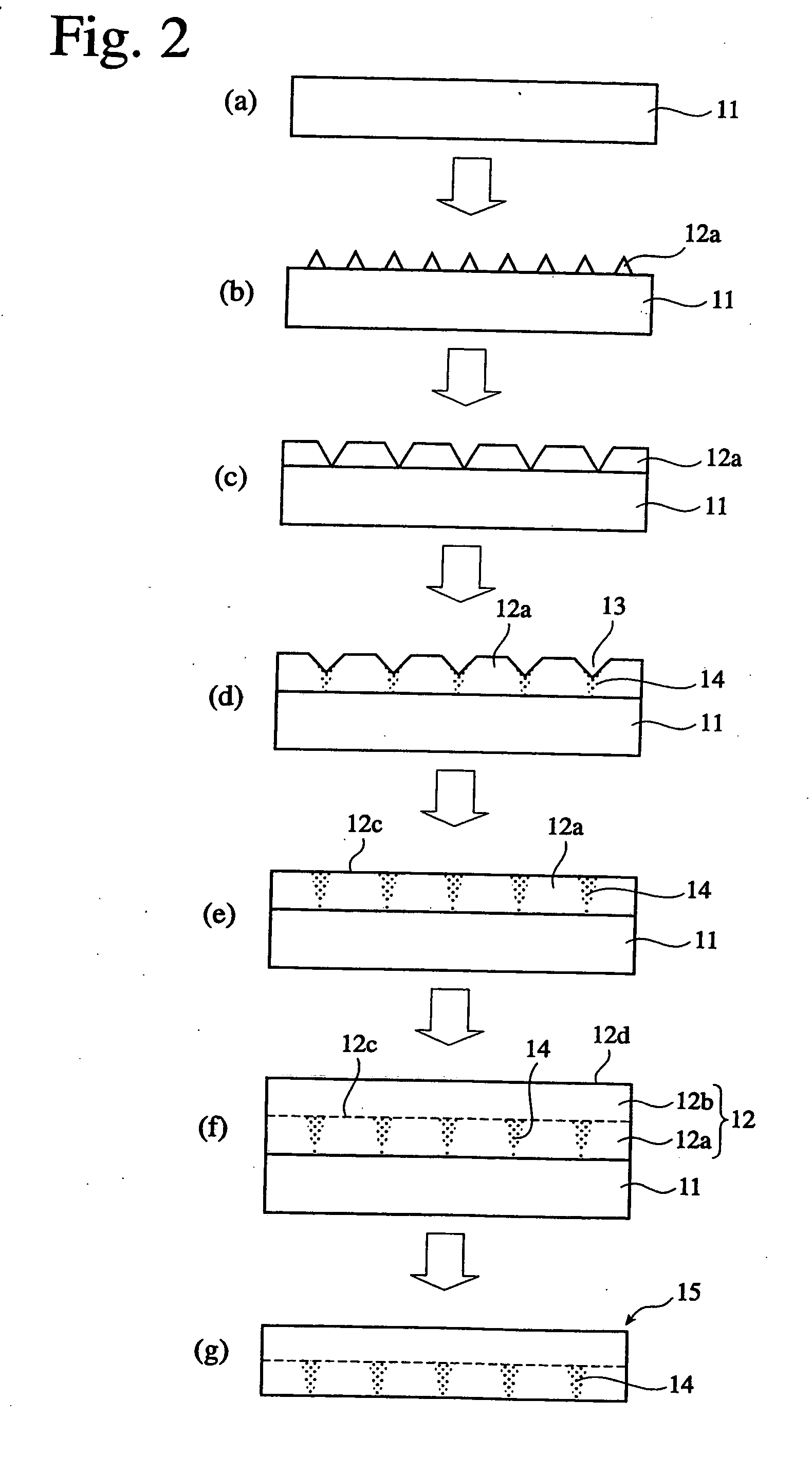III-V nitride semiconductor substrate and its production method
- Summary
- Abstract
- Description
- Claims
- Application Information
AI Technical Summary
Benefits of technology
Problems solved by technology
Method used
Image
Examples
example 1
[0077] An epitaxial GaN layer was grown on a sapphire substrate, and the sapphire substrate was then removed to produce and evaluate a self-supported GaN substrate 1 having a layer containing regions 2 having different carrier concentrations and a layer having a substantially uniform carrier concentration as shown in FIG. 1. The production method of the self-supported GaN substrate in this Example will be explained below referring to FIG. 2.
[0078] First, an epitaxial GaN layer 12a was grown on a sapphire substrate 11 by an HVPE method. The HVPE method is a method, in which GaCl, a halide of a group-III element, is transported onto a surface of a heated base substrate, and mixed with NH3 on the base substrate, so that they react with each other to cause the vapor-phase growth of a GaN crystal on the base substrate 11. The source gases are supplied with carrier gases such as H2 and N2. The temperature in a region surrounding the base substrate 11 was set at 1000° C. by an electric fu...
example 2
[0093] An epitaxial GaN layer was grown on a sapphire substrate substantially in the same manner as in Example 1 except for slight changes in crystal growth conditions in the HVPE method, and the sapphire substrate was removed to produce and evaluate a self-supported GaN substrate shown in FIG. 1. The production method of the self-supported GaN substrate in this Example will be explained below referring to FIG. 2.
[0094] First, an epitaxial GaN layer 12a was grown by the same HVPE method as in Example 1 using a C-plane sapphire substrate 11. The temperature on the substrate was set at 1050° C. by an electric furnace. The partial pressures of GaCl and NH3 as source gases were 6×10−3 atm and 0.4 atm, respectively, on the substrate, and the carrier gas used was a mixed gas of 10% H2 and 90% N2 from the initial stage. The GaN crystal was doped with Si by supplying SiH2Cl2 as a doping gas onto the substrate in the process of growing the GaN crystal.
[0095] First, nuclei of the GaN crysta...
example 3
[0101] An epitaxial GaN layer was grown on a sapphire substrate by a void-assisted separation (VAS) method, and the sapphire substrate was then removed to produce and evaluate a self-supported GaN substrate. The details of the VAS method are described in JP 2003-178984 A. Briefly, it is a method in which crystal growth is carried out with a thin film of titanium nitride having a network structure formed between the sapphire substrate and a growing GaN layer. A method for producing a self-supported GaN substrate in this Example will be described below referring to FIG. 7.
[0102] An undoped GaN layer 22 was grown to a thickness of 300 nm on a 2-inch-diameter, C-plane substrate 21 of a single crystal sapphire, with trimethylgallium (TMG) and NH3 as source gases by an MOVPE method [step (b)]. A metal Ti film 23 was then vapor-deposited to a thickness of 20 nm on this epitaxial GaN substrate 22 [step (c)], and the substrate was subjected to a heat treatment at 1050° C. for 20 minutes in ...
PUM
 Login to View More
Login to View More Abstract
Description
Claims
Application Information
 Login to View More
Login to View More - R&D
- Intellectual Property
- Life Sciences
- Materials
- Tech Scout
- Unparalleled Data Quality
- Higher Quality Content
- 60% Fewer Hallucinations
Browse by: Latest US Patents, China's latest patents, Technical Efficacy Thesaurus, Application Domain, Technology Topic, Popular Technical Reports.
© 2025 PatSnap. All rights reserved.Legal|Privacy policy|Modern Slavery Act Transparency Statement|Sitemap|About US| Contact US: help@patsnap.com



